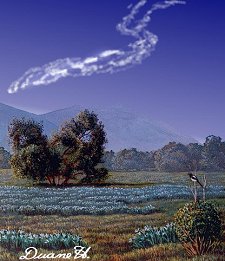|
Spring Shower the 2003 Lyrids The Lyrid meteor shower peaks in 2003 on April 22nd and 23rd. Sky watchers in the northern hemisphere can expect to see 10 to 20 meteors power hour. This is not a good shower for sky watchers in the southern hemisphere. Sky maps: northern hemisphere, southern hemisphere.
Right: Typical Lyrid meteors are about as bright as the stars in the Big Dipper, but some are more intense. Lyrid fireballs (a fireball is a meteor brighter than Venus) sometimes leave behind "persistent trains"--smokey trails that can linger in the night sky for minutes. Artist Duane Hilton painted this scene of a Lyrid persistent train drifting in the pre-dawn sky of California's Owens Valley, with blossoming wild irises in the foreground. Although Lyrid meteors seem to streak away from the vicinity of Vega, they have nothing to do with that distant star, which is 25 light years away. Lyrid meteoroids are bits of dusty debris shed by comet Thatcher (C/1861 G1) here within our solar system. Earth plows through Thatcher's debris stream with a relative velocity of 49 km/s (110,000 mph). Meteoroids usually no bigger than grains of sand strike Earth's atmosphere and disintegrate as fiery streaks of light. The Lyrid shower is prone to occasional outbursts. Most years in April there are no more than 10 to 20 meteors per hour during the shower's peak. But sometimes, when Earth glides through an unusually dense clump of comet Thatcher's debris, the rate increases. For instance, sky watchers in 1982 spotted 90 Lyrids per hour. An even more impressive outburst was documented in 1803 by a journalist in Richmond, Virginia, who wrote:
What will the Lyrids do this year? The only way to know for sure is to go outside and look. The best time to watch, no matter where you live, will be during the hours before dawn between about 2 a.m. and 5 a.m. local time on April 22nd and 23rd. Simply go outside and look up, generally toward the north. Sky watchers in rural areas should spot a shooting star every few minutes. The Lyrid meteor shower is best viewed from the northern hemisphere where its radiant lies high in the sky. Southern observers as far south as -30 degrees latitude will spot some Lyrids, but probably no more than a sprinkling. Experienced meteor watchers suggest the following viewing strategy: Dress warmly. Bring a reclining chair, or spread a thick blanket over a flat spot of ground. Lie down and look up somewhat toward the east. Meteors can appear in any part of the sky, although their trails will tend to point back toward the radiant. Related links:
|
 Lyrid
meteors appear to stream from a point in the sky (called "the
radiant") near Vega--a brilliant blue-white star about three
times wider than our Sun. Around 14,000 years ago Earth's wandering
spin axis pointed toward Vega--it, not Polaris, was the North
Star. More recently Vega gained fame as an important star in
Carl Sagan's movie Contact. If you live at mid-northern
latitudes,Vega will lie almost directly overhead before the Sun
rises any morning in late April.
Lyrid
meteors appear to stream from a point in the sky (called "the
radiant") near Vega--a brilliant blue-white star about three
times wider than our Sun. Around 14,000 years ago Earth's wandering
spin axis pointed toward Vega--it, not Polaris, was the North
Star. More recently Vega gained fame as an important star in
Carl Sagan's movie Contact. If you live at mid-northern
latitudes,Vega will lie almost directly overhead before the Sun
rises any morning in late April.